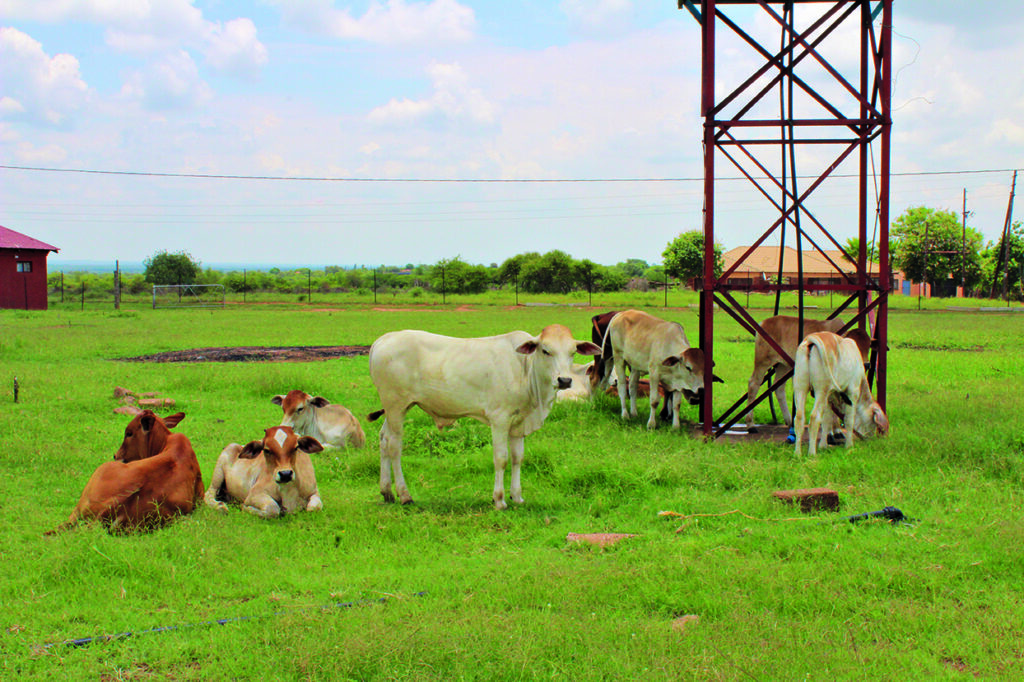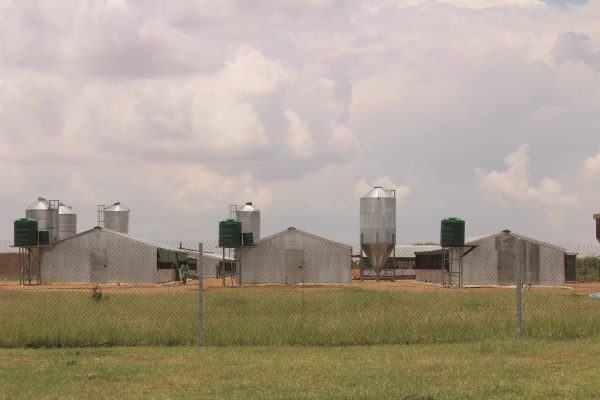In the early 2000s, Dineo Mokgoshi was on the lookout for new investment opportunities when a family member told her that cattle farming was a lucrative business offering great returns.
During that time, she had a fulltime job and ran a few side hustles which included catering for functions and hosting international tourists.
“My friend and I ran a tourist hosting company at the Fountain Valley Resort in Groenkloof Nature Reserve in Pretoria. We set up a caravan and camping site and let caravans and tents to tourists who enjoyed the city, but preferred being outside in nature than staying in hotels. Tourists, especially Europeans, loved the experience and paid good money for it,”

In 2005, Dineo bought 26 mixedbreed cows and a white Brahman bull using her bonus and her savings. Residing in Pretoria at the time, she ran the cattle on land belonging to her inlaws in Winterveld, about 40km north-west of the city.
“I learnt the basics of farming by reading any material I could find.”
That’s how she came across an article in a magazine that changed her perspective on farming forever.
“I saw it as a part-time gig. I didn’t really intend to get my hands dirty, let alone move to the rural areas.”
The article was about Dorah Matlou from Limpopo in Rust de Winter. Dorah’s story on how she overcame many challenges to establish a profitable award winning farming operation touched Dineo’s heart and gave her courage.
“I promised myself I would follow her lead; she’d be my role model.”
15 years later, Dineo has stayed true to her words. She has since launched Segometsi Bakgoshi Agricultural Cooperative, a successful mixed-farming operation with 48 000 laying hens, 120 Pinzgauer cattle and a PinZ²yl stud herd, flocks of more than 120 sheep and goats, as well as a commercial cattle herd of 133 Brahman-type animals.
“We’ve just finished building a 25 000-layer house, which means we can take the layer operation to 73 000 birds.”
She currently employs 16 employees and also offers practical training to 22 university students each and every year.
According to Dineo, things weren’t easy in the beginning, it was a very long and tough journey.
“We worked extremely hard to get to where we are today. I owe so much to my supportive family, especially my husband. When we sold the house and left the cushy suburban lifestyle to move to Winterveld, he was right behind me.”
They relocated to Winterveld after the increase in cattle numbers could no longer be accommodated on the inlaws’ small family plot.
“I also learnt from Dorah’s story, and from other successful farmers, that being on the farm full time is non-negotiable when you’re building a successful enterprise.”
In 2009, on her way to a friend’s birthday celebration, she spotted vacant land in Winterveld. After spending many months searching for the family of its deceased owner, she finally managed to buy the 17ha plot in 2010.
At the time, business was booming thanks to South Africa being the host of the 2010 Fifa World Cup.
“I built my house, moved in and started setting up infrastructure for the livestock. Because it is not a big piece of land, we were and still are part of the communal grazing system. Our cattle graze on the communal area during the day and we bring them back to kraal at home in the evening.”
She diversified her livestock and bought buying sheep and goats.

However, she soon realised that livestock didn’t generate a consistent cash flow, so she decided to venture into poultry and bought 7 000 broilers in 2013. Unfortunately, she was quickly hit by a hailstorm that killed all the chickens and 19 cattle.
“I picked myself up and dusted off the terrible losses. The following year I entered the Gauteng Female Farmer of the Year Awards and came second where I won R40 000.”
The prize money gave her the motivation to try poultry again but instead of going for broilers like the last time, she went for layers instead.
“I built three 2 000-layer houses in 2015, but funds ran out halfway through the project.”
She was forced to sell 8 bull calves to finish the project but another problem came in creeping, there wasn’t no money to buy chickens.
“We underbudgeted, estimating a cost of R40 to R55 a bird. To my shock, a single bird was R90 at that time.”
Dineo was stuck with empty cages for a couple of months until January 2016, when she was finally able to access government support. Thousand layers, with the necessary feed, were delivered to her farm.
“They weren’t enough to fill a house, but it was a start!”
By chance, she saw an invitation in a newspaper calling for bidders to supply Gauteng government hospitals in Ekurhuleni with 100 boxes of eggs a day.
Despite having 1000 chickens producing 5 boxes of eggs each day, she still jumped at the opportunity. In the end, she managed to get the contract and then had to source 95 more boxes from other farmers.
The business generated a healthy profit through this contract, which gave her the leverage to increase her own capacity. Soon enough, the other two houses were filled with layers, and she later on built 3 more houses, each with a 5 000-layer carrying capacity.
When the contract ended in June 2018, Dineo had increased her capacity to 48 000 birds.
“I’ve recently built another 25 000-layer house. Once this one is equipped and stocked, my production will rise to 73 000 laying hens,”
Her goal is to increase production by a further 100 000 layers.
Advice to aspiring farmer?
“A person needs to have passion for farming. Many people don’t have this passion on. Farming is not an easy thing to do.”
Get South Africa’s latest entrepreneurial or business success stories delivered right to your inbox — Sign up to Entrepreneur Hub SA’s newsletter today ⬇️⬇️⬇️

eBook: 50 South African Entrepreneurs Reveal HOW THEY MADE IT





Wow, awesome blog format! How lengthy have you ever been running a blog for?
you make blogging glance easy. The overall glance of your site is wonderful,
as smartly as the content material! You can see similar
here e-commerce
Hello! Do you know if they make any plugins to help with
Search Engine Optimization? I’m trying to get my website to rank for
some targeted keywords but I’m not seeing very good success.
If you know of any please share. Cheers! I saw similar art here:
Scrapebox AA List
Wow that was strange. I just wrote an really
long comment but after I clicked submit my comment didn’t appear.
Grrrr… well I’m not writing all that over again. Anyway, just wanted to say excellent blog!
My website vpn 2024
Hello, after reading this awesome piece of writing i
am also cheerful to share my experience here with colleagues.
Have a look at my web site :: vpn coupon code 2024
https://bit.ly/baccarats888com
You’ve made some really good points there. I checked on the net to find out more about the issue and found most people will go along with your views on this site.
https://rebrand.ly/bacacarat888
I have to thank you for the efforts you have put in penning this website. I’m hoping to check out the same high-grade blog posts from you in the future as well. In fact, your creative writing abilities has motivated me to get my own website now 😉
Magnificent web site. A lot of helpful info here.
I’m sending it to several friends ans additionally sharing in delicious.
And naturally, thanks on your effort!
My homepage – vpn coupon 2024
https://bit.ly/baccarats888com
Piece of writing writing is also a fun, if you be familiar with afterward you can write otherwise it is complicated to write.
https://rebrand.ly/bacacarat888
I am extremely inspired with your writing talents as smartly as with the structure to your weblog. Is this a paid theme or did you modify it your self? Either way stay up the excellent high quality writing, it is rare to see a great blog like this one today..
https://bit.ly/baccarats888com
This is really interesting, You’re a very skilled blogger. I have joined your rss feed and look forward to seeking more of your magnificent post. Also, I have shared your website in my social networks!
Wow, fantastic blog layout!
How long have you been blogging for? you made blogging look easy.
The full look of your web site is wonderful, let alone the content!
I saw similar here prev next and those was
wrote by Cory81.
Wow, marvelous weblog layout!
How long have you been running a blog for? you made blogging glance easy.
The overall glance of your website is wonderful, as smartly
as the content! You can read similar here prev next and it’s was wrote by Deloris73.
https://rebrand.ly/bacacarat888
Do you mind if I quote a couple of your posts as long as I provide credit and sources back to your blog? My blog is in the exact same area of interest as yours and my visitors would really benefit from some of the information you provide here. Please let me know if this ok with you. Regards!